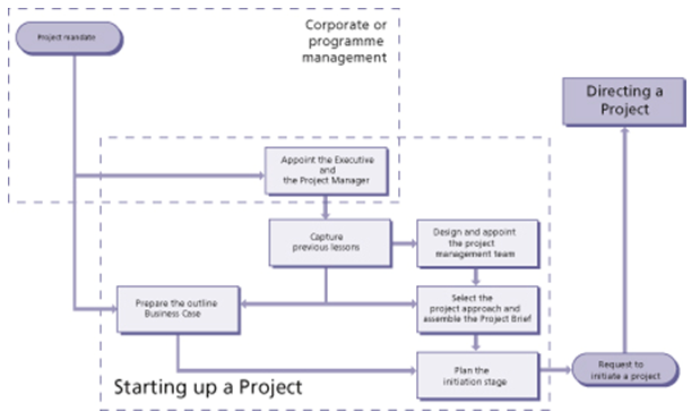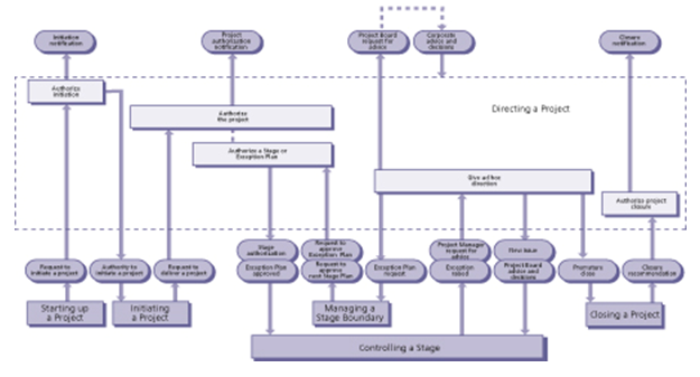Start Up and Direct a Project
This week, learning is broken into two parts:
- A summary of the first two processes in more detail than last week. The first two processes are:
- Starting up a Project
- Directing a Project
- Learning activities that will contribute to the development of a Project Management Plan.
Scroll down to read.
Part 1
Starting up a Project
Starting Up a Project is the process that takes the Project Mandate to a point where a Request to Initiate a Project can be made. A project mandate is the trigger for the project that comes from upper management when they say they want the project to go ahead and create a Specialist Product that is external to normal ongoing business. The diagram below illustrates what is involved in stating up a project:

Before appointing the Executive and the Project Manager, Corporate/Programme Management (or upper management) needs to produce (I use the word produce here because PRINCE2 refers to outputs as products):
- A project mandate
- A role description for the Executive
- Appoint an Executive.
The Executive then needs to produce:
- A role description for the Project Manager, which Corporate needs to approve
- Appoint a Project Manager, which Corporate needs to approve
- The Business Case, which takes time and is developed at the same time the project manager carries out some initial responsibilities such as assembling the team and producing the Project Product Description.
The Project Manager then needs to produce:
- A Daily Log, which will become a living document that is updated throughout the life of the project.
- A Lessons Log, which is reviewed by the Executive. The lessons log captures lessons from previous projects and helps projects continuously improve by minimising the likelihood of repeated issues.
- Project Management Team structure, approved by the Executive
- Role descriptions for the Project Management team, approved by the Executive
- Appoint the project management team, approved by the Executive or this might be produced by the Executive and approved by Corporate
- Project Product Description (PPD) after reviewing an outline of the Business Case or the actual Business Case if it is completed. The PPD will approved by the Project Board
- Project Approach, which is approved by the project board
- Additional role descriptions if required
- Project Brief, which is approved by the project board, and the Daily Log is continually updated
- Stage Plan as part of planning the initiating stage. The stage plan is approved by the Project Board and reviewed by Project Assurance.
Directing a Project
Including the Directing a Project process in the project management methodology (PRINCE2) enables the Project Board to be genuinely accountable for the success of the project. The project board can make key decisions and at the same time delegate day to day management decisions to the project manager. This type of organisational structure is essential for effective governance to be put in place. The diagram below illustrates what is involved and when in the process of directing a project:

Key to the directing a project process are the steps of gaining approval and reviewing of products. Approving and Reviewing have specific meanings.
- Approving is formally confirming that a product is complete, and meets requirements as defined by the product description. In other words, approval is a measure of progress.
- Reviewing is the assessing of a product to determine if it is complete, and meets requirements as defined by the product description. The reviewer must be independent of the producer. In other words, reviewing is a quality assurance process.
The following table provides examples of Products, and then identifies the stage in which they are produced, who is responsible for their production, the who approves and reviews them. Note the table does not contain an exhaustive list of products influenced by the direct a project process, and products produced by corporate or the project board would be more common in the Start up a Project process, which occurs prior to initiation.
| Product | Stage | Producer | Corporate | Executive | Senior User | Senior Supplier | Project Manager | Project Assurance |
| Project Brief | Initiation | Project Manager | R | A | A | A | R | |
| Initiation Stage Plan | Initiation | Project Manager | A | A | A | R | ||
| Lessons Log | Project Authorisation | Project Manager | R | R | R | R | ||
| Benefits Review Plan | Project Authorisation | Project Manager | A | A | A | A | R | |
| Stage Plans | Stage Authorisation | Project Manager | A | A | A | R | ||
| Specialist Products | Stage Authorisation | Team Manager | A | A | A | R | R | |
| End of Stage Reports | Stage Authorisation | Project Manager | A | A | A | R | ||
| Actions and recommendations | Stage Authorisation | Project Manager | A | A | A | R | ||
| Exception Plan | Stage Authorisation | Project Manager | A | A | A | R | ||
| New Issue | Ad hoc Direction | Could be Corporate or any of the Project Board | ||||||
| End of Project Report | Authorise Closure | Project Manager | A | A | A | R | ||
| Lessons Report | Authorise Closure | Project Manager | A | A | A | R | ||
| Updated Business Case | Authorise Closure | Project Manager | R | A | A | A | R | |
| Updated Benefits Review | Authorise Closure | Project Manager | A | A | R | R | R |
Media Attributions
- starting_up_a_project_context
- directing_a_project_context
